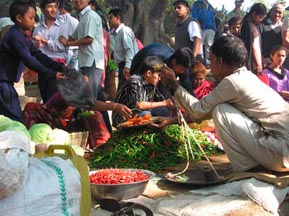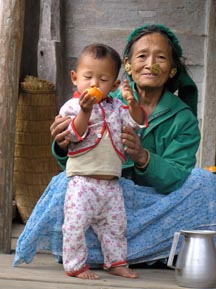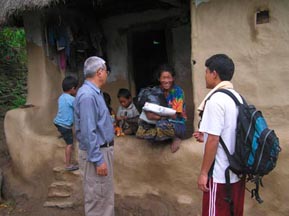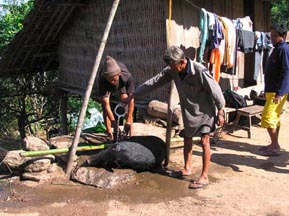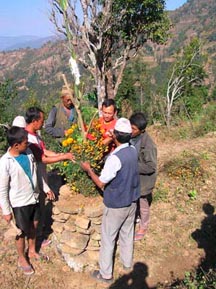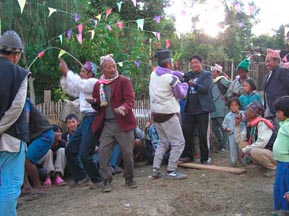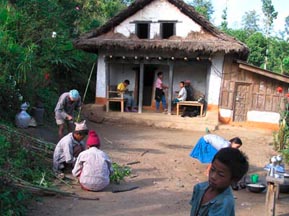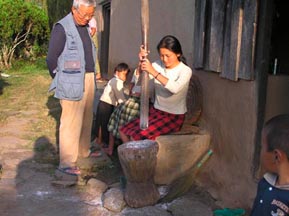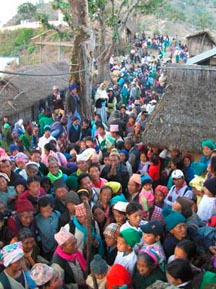Research projects
Communicative environment
In this study we are comparing the development of basic intention-reading skills and the communicative environment of the 6 Chintang children with that of 6 children from a German township matched for age and gender. We are coding for communicative behaviors such as pointing, attention getting, offering and imitation and for who initiates these behaviors, and in the case of the children, to whom. The question is whether there are significant cross-cultural differences to be found or whether similarities in socio-communicative behavior are more dominant.
Researchers:
Elena Lieven, Sabine Stoll
Research assistants:
Nicole Lorenz, Kristin Wolter
Pointing
In a more detailed study of the 4 older Chintang children, we are looking at pointing by, and to them and comparing this to 4 German and 4 Russian children. We are interested in the children’s pointing behaviour and the language that accompanies pointing and whether this differs between cultures and/or interlocutors.
Researchers:
Sabine Stoll, Elena Lieven
Research assistants:
Nicole Lorenz, Tatjana Krämer, Matthias Zeiske, Dana Langner
Child surrounding speech vs. child directed speech
In this study we compare whether there is a difference in the structure of the language that is addressed to children in Chintang vs. the language that surrounds them but is not explicitly addressed to them. Every utterance not uttered by the child is coded for this feature (child directed vs. child surrounding). The relative proportions of each are compared across children and over time. The goal is to find out whether there are strong individual differences in the input to the target children and if so whether these differences are reflected in the speech of the children.
Researchers:
Nicole Kantak, Sabine Stoll, Elena Lieven
Research assistant:
Dana Langner
Reference:
Kantak, N. (2011). Die natürlichsprachliche Umgebung in der ein Kind in Chintang aufwächst. M.A. Thesis, University of Leipzig. [PDF]
Mixing in Chintang and Nepali
From early on Chintang children are surrounded by Chintang and Nepali, the Indo-European lingua franca of Nepal. Especially when they enter school, children become more proficient in Nepali, which is the only medium of instruction at their schools. The question addressed in this study is whether children mix the two languages and in what way, i.e. do they mix within utterances only or also within words and how this compares with the language mixing of other speakers.
Researchers:
Sabine Stoll, Elena Lieven
The acquisition of nouns and verbs
Research on a wide variety of typologically unrelated languages has shown that there is a lot of variation in the relative proportions of nouns and verbs in children's early vocabularies. In some languages nouns predominate and in other languages, such as Korean or Mandarin Chinese, verbs predominate. From the distribution in the input we would expect that Chintang children from early on prefer verbs. However, from the complexity of morphology involved in verb paradigms, we would rather expect that children avoid verbs and focus on nouns in early acquisition. The latter expectation was confirmed in a longitudinal study comparing the use of nouns and verbs in the four target children (2-year-olds and 3-year olds). The study shows that as soon as children become more proficient with the complex verb morphology they also approach the adult distributions of nouns and verbs.
Researchers:
Sabine Stoll, Balthasar Bickel, Elena Lieven
Reference:
Stoll, S., Bickel, B., Lieven, E., Paudyal N., Banjade G., Bhatta, T., Gaenszle, M., Pettigrew, J., Rai, M., Rai N. (2011). Nouns and verbs in Chintang: children's usage and surrounding adult speech. Journal of Child language. [PDF]
The acquisition of ergative case in Chintang
Chintang has a split ergative system conditioned by person marking. In the first person the ergative is ungrammatical, in the 2nd person it is optional and only in the third person is ergative marking obligatory. However, due to heavy argument ellipsis the marker does not occur reliably in the input. The study compares ergative marking in the input with the patterns found in the individual target children. Interestingly, from a quantitative point of view the patterns of the children are very similar to the patterns in the input. Also, no overgeneralizations of the ergative to the S argument in intransitive sentences are found. This suggests that children instead of relying on a gentility bias from early on focus on the distributions found in the input. The goal of the study is to find out about the strategies children use in learning the ergative case in Chintang. We found that in the earliest recordings imitations are more prevalent and only in the later contexts they use the ergative spontaneously.
Researchers:
Sabine Stoll, Balthasar Bickel, Elena Lieven
Reference:
Stoll, S., Bickel, B., in press. The acquisition of ergative case in Chintang. In: Bavin, E., Stoll, S. (Eds.) The acquisition of ergativity. Benjamins. [PDF]
Spatial expressions
Spatial expressions can be specific or general in their meaning. For instance, the English preposition 'at' has rather general spatial semantics meaning that the figure object is in spatial proximity to or in contact with the ground object (but with no specific spatial relation to it), whereas 'in' has more specific spatial semantics meaning that the figure object is contained within the ground object. Just as English, Chintang has also spatial expressions with more general spatial semantics (e.g., demonstrative pronouns) and ones with more specific spatial semantics (especially topological expressions making use of relational nouns). However, expressions with specific spatial semantics are extremely rare in Chintang discourse and therefore infrequently heard by Chintang learning children. In this study, we want to investigate how the distribution of expressions with general and specific spatial semantics differ in child language corpora of English and Chintang and how this influences the use and acquisition of spatial expressions in both languages.
Researchers:
Sebastian Sauppe, Sabine Stoll und Balthasar Bickel
